Cluain Aoibhinn, Maynooth, County Kildare, Sunday evening, 9 July:
Friday and Saturday were fairly uneventful apart from our removal here to County Kildare, to a town within easy public transport of Dublin. We had five hours for a mere 80 miles, and by way of dawdling we took in a whiskey museum, the old John Locke distillery in Kilbeggan. (John Locke whiskeys are still made, but now in Laois, though Kilbeggan remains the one town named on the label.) We had been led to expect a raconteur experience, but were disappointed of that, being shown the place by a slip of a girl who lacked the confidence and experience to fill the raconteur role with any conviction. Our house for this week is a decided improvement over last week's in most respects; ditto for the town it is in. Larissa was crushed when the local bookstore had already run out of the new Harry Potter book when we arrived (it had been released that same day), but we reserved a copy of the next shipment, due Tuesday, and the bookseller gave Larissa two of the book posters as consolation.
 Today we engaged a professional storyteller as a tour guide: Richard Marsh of "Legendary Tours," a native of Detroit but resident here for a score of years. We arrived early for our rendezvous with him by the O'Connell Street bridge, and while walking about for a few blocks we encountered another storyteller, who unfortunately did not appear to be in a talkative mood at the time.
Today we engaged a professional storyteller as a tour guide: Richard Marsh of "Legendary Tours," a native of Detroit but resident here for a score of years. We arrived early for our rendezvous with him by the O'Connell Street bridge, and while walking about for a few blocks we encountered another storyteller, who unfortunately did not appear to be in a talkative mood at the time.
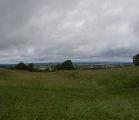 With Richard navigating, we drove to the hill of Tara, the ancient capital of the pre-Christian High Kings of Ireland. He seemed very well informed and I was inclined to believe his account of the part shown here (though it was identified by sign as "banqueting hall") as a ceremonial entrance road, which was also a section of a "god-line"--that is, a section of a cross-country road originally built to facilitate the movements of gods or spirits rather than those of human beings, for whom it was not even practicable, as the straight-line design made no accommodation for even the most extreme topography. Richard pointed out a bit of paved road in the distance (scarcely identifiable in this photo) that would appear to be another bit of the same god-line.
With Richard navigating, we drove to the hill of Tara, the ancient capital of the pre-Christian High Kings of Ireland. He seemed very well informed and I was inclined to believe his account of the part shown here (though it was identified by sign as "banqueting hall") as a ceremonial entrance road, which was also a section of a "god-line"--that is, a section of a cross-country road originally built to facilitate the movements of gods or spirits rather than those of human beings, for whom it was not even practicable, as the straight-line design made no accommodation for even the most extreme topography. Richard pointed out a bit of paved road in the distance (scarcely identifiable in this photo) that would appear to be another bit of the same god-line.
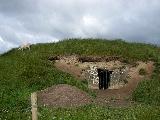 Here is the mound, a small passage-tomb, that figures in the same story I told the children Thursday, of how the hero Finn or Fionn mac Cumhail came to captain the elite military order called the Fianna. The opening communicates with the Otherworld, and the faery goblin Aillin would emerge from it nightly to burn Tara, using his harp to lull to sleep all potential resistance. In the version Richard told, Fionn deafened himself with a magic cap and killed Aillin with the magic spear (and there was no mention of his claiming the harp as trophy). Richard reassured the children that the iron gate was impassable to the Sidhe, as the faery people or Tuatha Dé Danann are known. He speculated that perhaps one reason for periodic human gatherings at Tara was to guard against invasions by the Sidhe through this portal.
Here is the mound, a small passage-tomb, that figures in the same story I told the children Thursday, of how the hero Finn or Fionn mac Cumhail came to captain the elite military order called the Fianna. The opening communicates with the Otherworld, and the faery goblin Aillin would emerge from it nightly to burn Tara, using his harp to lull to sleep all potential resistance. In the version Richard told, Fionn deafened himself with a magic cap and killed Aillin with the magic spear (and there was no mention of his claiming the harp as trophy). Richard reassured the children that the iron gate was impassable to the Sidhe, as the faery people or Tuatha Dé Danann are known. He speculated that perhaps one reason for periodic human gatherings at Tara was to guard against invasions by the Sidhe through this portal.
 Here Ariadne follows Richard's instructions to take a turn around the Lia Fáil, the Stone of Destiny, keeping her right side towards it as a gesture of respect. Brought to Ireland along with other wonders by the Tuatha Dé Danann, this stone was a test of kingship: claimants would have to leap up to a standing position on top of it, and the stone would cry out if the claimant was the destined and true king. Some hold that the Stone of Scone, long held in England but recently returned to Scotland, is the real Lia Fáil, but others say that this is and that it never left Tara.
Here Ariadne follows Richard's instructions to take a turn around the Lia Fáil, the Stone of Destiny, keeping her right side towards it as a gesture of respect. Brought to Ireland along with other wonders by the Tuatha Dé Danann, this stone was a test of kingship: claimants would have to leap up to a standing position on top of it, and the stone would cry out if the claimant was the destined and true king. Some hold that the Stone of Scone, long held in England but recently returned to Scotland, is the real Lia Fáil, but others say that this is and that it never left Tara.
 After Tara, and a visit to the nearby Hill of Slane, we proceeded to Ardee. It was at this ford of the river Dee that Cúchulainn slew in single combat his dearest friend from boyhood, Ferdia. It is one of the most tragic passages of the Táin, and the climax of a whole series of single combats fought by Cúchulainn at such fords. I asked Richard why fords always seemed to be the sites of combats in the Táin; he speculated that it had to do with rivers as natural boundaries, and gave the fights Otherworldly overtones of significance, without diminishing their very literal reality. (Compare how the demon Grendel is called "walker of the borders" in Beowulf.)
After Tara, and a visit to the nearby Hill of Slane, we proceeded to Ardee. It was at this ford of the river Dee that Cúchulainn slew in single combat his dearest friend from boyhood, Ferdia. It is one of the most tragic passages of the Táin, and the climax of a whole series of single combats fought by Cúchulainn at such fords. I asked Richard why fords always seemed to be the sites of combats in the Táin; he speculated that it had to do with rivers as natural boundaries, and gave the fights Otherworldly overtones of significance, without diminishing their very literal reality. (Compare how the demon Grendel is called "walker of the borders" in Beowulf.)
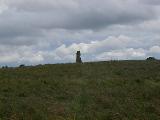
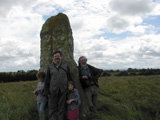 Near Dundalk, Richard showed us the pillar-stone to which Cúchulainn lashed himself, after receiving his mortal wound from Lughaid, so as to die in a standing position and facing his enemies. (There is also another story of Cúchulainn's death, in which he goes mad after slaying his own son, wades into the surf to fight the waves, and drowns. Richard suggests that this one is a crossover from some other hero's myth.) As with the Ford of Ferdia, the identification of this specific field as the "field of slaughter" rests on local tradition, but it is entirely consistent with the ancient manuscript sources for the myth.
Near Dundalk, Richard showed us the pillar-stone to which Cúchulainn lashed himself, after receiving his mortal wound from Lughaid, so as to die in a standing position and facing his enemies. (There is also another story of Cúchulainn's death, in which he goes mad after slaying his own son, wades into the surf to fight the waves, and drowns. Richard suggests that this one is a crossover from some other hero's myth.) As with the Ford of Ferdia, the identification of this specific field as the "field of slaughter" rests on local tradition, but it is entirely consistent with the ancient manuscript sources for the myth.
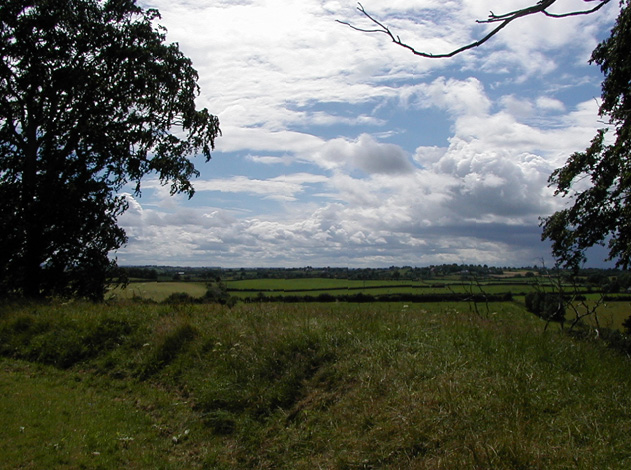 Finally, we visited the site of Cúchulainn's stronghold or rath, long since overlaid with a twelfth-century Anglo-Norman earthwork or "motte," the top of which is seen here in the foreground. It overlooks his traditional domain, the plain of Muirtheimne.
Finally, we visited the site of Cúchulainn's stronghold or rath, long since overlaid with a twelfth-century Anglo-Norman earthwork or "motte," the top of which is seen here in the foreground. It overlooks his traditional domain, the plain of Muirtheimne.
previous entry
next entry
main/ToC page
 Today we engaged a professional storyteller as a tour guide: Richard Marsh of "Legendary Tours," a native of Detroit but resident here for a score of years. We arrived early for our rendezvous with him by the O'Connell Street bridge, and while walking about for a few blocks we encountered another storyteller, who unfortunately did not appear to be in a talkative mood at the time.
Today we engaged a professional storyteller as a tour guide: Richard Marsh of "Legendary Tours," a native of Detroit but resident here for a score of years. We arrived early for our rendezvous with him by the O'Connell Street bridge, and while walking about for a few blocks we encountered another storyteller, who unfortunately did not appear to be in a talkative mood at the time.






